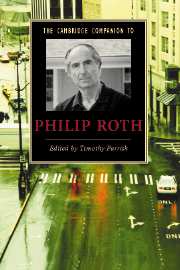Book contents
- Frontmatter
- Introduction: Roth at mid-career
- 1 American-Jewish identity in Roth’s short fiction
- 2 Roth, literary influence, and postmodernism
- 3 Zuckerman Bound: the celebrant of silence
- 4 Roth and the Holocaust
- 5 Roth and Israel
- 6 Roth’s doubles
- 7 Revisiting Roth’s psychoanalysts
- 8 Roth and gender
- 9 Roth and ethnic identity
- 10 Roth’s American Trilogy
- 11 Roth’s autobiographical writings
- Further reading
- Index
8 - Roth and gender
Published online by Cambridge University Press: 28 May 2007
- Frontmatter
- Introduction: Roth at mid-career
- 1 American-Jewish identity in Roth’s short fiction
- 2 Roth, literary influence, and postmodernism
- 3 Zuckerman Bound: the celebrant of silence
- 4 Roth and the Holocaust
- 5 Roth and Israel
- 6 Roth’s doubles
- 7 Revisiting Roth’s psychoanalysts
- 8 Roth and gender
- 9 Roth and ethnic identity
- 10 Roth’s American Trilogy
- 11 Roth’s autobiographical writings
- Further reading
- Index
Summary
With the publication of My Life as a Man in 1974, Philip Roth brought into sharp focus subject matter that has continued to preoccupy him for most of his career. When his protagonist, the writer Peter Tarnopol, struggles to make sense of his anguished life by dropping the guise of fiction and telling his story “straight,” words such as “man,” “manly,” and “manhood” recur like the restless beat of a drum. “What's the matter with men?” complains a minor female character, “What do they want?” Echoing Freud's famous rhetorical question about women's sexuality, her peevish queries indicate that neither male heterosexual desire nor masculine identity is understood by the men who desire or the women who stand outside or as objects of such desire. Tarnopol reflects mid-twentieth-century American values when he equates legitimate selfhood with masculinity: “I wanted to be humanish: manly, a man” (My Life as a Man, 174). At the same time, he identifies the yoke under which he labors as an ideological construction, asserting how “strong was the myth of male inviolability, of male dominance and potency” (173). The myth - and its unmasking - propels many of Roth's plots; his concern with questions of gender has been almost wholly confined to the trials of manhood. When he confessed to an interviewer in 1997 that “the lives of men has been my subject,” Roth found an apt metaphor for that subject: “the circus of being a man . . . and the ringleader is the phallus.”
- Type
- Chapter
- Information
- The Cambridge Companion to Philip Roth , pp. 111 - 126Publisher: Cambridge University PressPrint publication year: 2007
- 2
- Cited by



